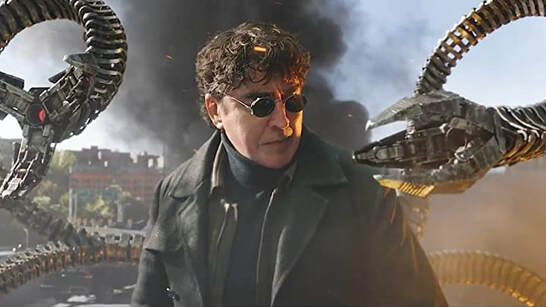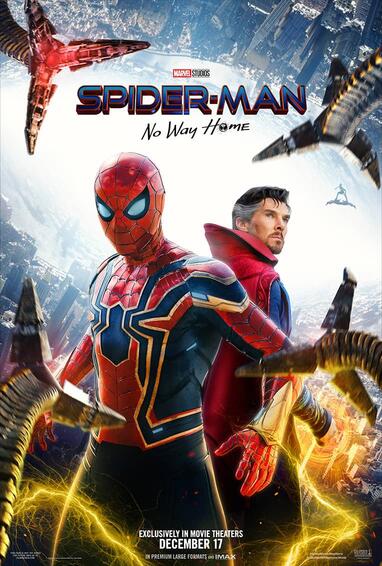Written by Zeke Perez Jr.  Caution: This article contains spoilers for the motion picture ‘Spider-Man: No Way Home’. Spider-Man: No Way Home swung into theaters carrying the burden of high expectations. In addition to picking up the cliffhanger ending to Far From Home, this installment was also responsible for carrying the MCU’s momentum into Phase Four and answering questions about the multiverse, while also dodging swirling rumors about surprise returns. With several former villains confirmed to return, it was also charged with seamlessly weaving together iconic actors and characters from every era of Spider-Man movies. In all, there was a lot for it to live up to. Fortunately for Spidey and Marvel fans past and present, No Way Home went above and beyond in what it delivered. As we’ve seen in past MCU movies, it takes a delicate balance to bring together an entire roster of characters while giving each adequate screen time and depth. No Way Home succeeds in merging together three separate Spider-Man franchises, accounting for each of their strengths and flaws, and finding a way to make them coexist in one universe. We got each of the villains that were confirmed in the trailer: Willem Dafoe’s Green Goblin, Alfred Molina’s Doctor Octopus, Jamie Foxx’s Electro, Thomas Haden Church’s Sandman, and Rhys Ifans’ Lizard. As many hoped, we got Tobey Maguire and Andrew Garfiled reprising their roles as Spider-Man to the cheers of packed theaters everywhere. We dove deep back into Marvel’s Netflix catalog for a quick cameo from your friendly neighborhood very-good-lawyer Matthew Murdock (cementing this as the greatest film in superhero history, in my humble opinion). Factoring in Doctor Strange, MJ, Ned, Aunt May, Happy, Wong, and J. Jonah Jameson on top of all of that, everything comes together surprisingly neatly. With the possible exception of Sandman and Lizard, who have more limited screen time, all of the characters’ roles and motivations are made clear, especially for viewers familiar with the previous movies.  It all melds with a surprising amount of chemistry, too. All three Spider-Men are at their absolute best, each perfectly personifying their version of the wall-crawler. The moments when they appear on-screen together are some of the most magical and inspiring, especially as the two older Spider-Men share with Holland their struggles and experiences as regular people trying to be heroes. They bond over both humorous discussions of their abilities and the villains they’ve battled and over a deeply emotional conversation about loved ones they have lost No Way Home is a redemption tale in many ways. It allows Maguire and Garfield to put the best aspects of their characters on screen again and it gives Garfield’s Peter Parker the chance to heal his emotional scars. It seeks to cure and ultimately save each of the villains. And, above all, it remedies the missteps made within the previous franchises, mixing nostalgia with new steps forward. On top of its achievements in fusing together three franchises, No Way Home deserves credit for what it does as a standalone Spider-Man story. The tone of this film starts very similarly to the preceding entries in the trilogy: chaotic but still light and focused on Peter’s immediate circle. Even as all of the world begins to find out that Peter is Spider-Man, the movie first looks at how that impacts his friends, family, and school life. The focus shifts pretty rapidly from there, becoming an extremely emotional and sometimes dark story by the third act.  The case can be made that we finally get the true origin story for Holland’s Spider-Man in this film. Both Maguire and Garfield’s characters were dealt big blows early on in their arcs that forced them to weigh the meaning of being a superhero. While we began to see some similar character development for Tom Holland’s Peter Parker as he deals with the loss of Tony Stark in Avengers: Endgame and Far From Home, his transition into the role of Spider-Man has definitely seen the stakes ramp up with each movie. No Way Home accelerates everything at a blinding speed, as we see Peter nearly break under the pressure of his alter-ego negatively affecting those around him and taking his Aunt May from him. Holland gets to add a more dramatic portrayal of Peter Parker to the charismatic side we had seen from him before. No Way Home played to the past and present of the MCU extremely well, and it also moved forward in setting up the MCU’s future. At this point, over two dozen movies and several TV shows in, the MCU is a tangled, sprawling web of characters and storylines, with the connections between those threads growing only more ambitious. Aside from bringing in characters from prior iterations of Spider-Man and from other Marvel properties, it created further linkages to the Disney+ shows (including a reference to a quote from Yelena in Hawkeye about the new-and-improved Statue of Liberty). The mid-credits scene pulls Venom into the MCU, leaving massive ramifications for upcoming Sony projects like Morbius. The movie also finishes setting up the events of Doctor Strange in the Multiverse of Madness, culminating in a post-credits trailer. With everything it took on in furthering the MCU, Spider-Man: No Way Home rises to the ranks of Avengers: Endgame. It makes its mark as not only a top Spider-Man movie, but as a top MCU movie. It’s rare in the era of social media that audiences are truly surprised leaving a blockbuster movie with so many expectations. Marvel and the film’s marketing team (and Tom Holland… *cough cough*) deserve a lot of credit for protecting and disguising so many secrets through the release date. Because they did, No Way Home is one of those movies that, years from now, you’ll wish you could experience again for the first time, taking in all of the surprises and emotions anew.
0 Comments
Leave a Reply. |
Archives
March 2025
|
|
© 2012-2025, Nerds That Geek LLC.
All Rights Reserved. |
uWeb Hosting by FatCow


 RSS Feed
RSS Feed